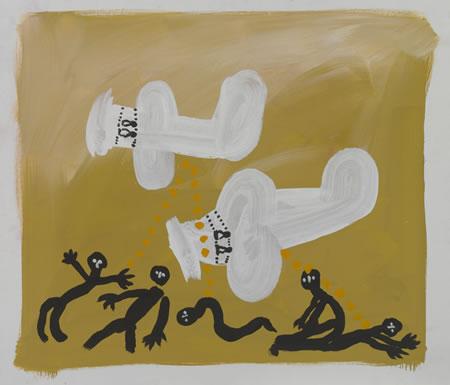Allies in adversity, Australia and the Dutch in the Pacific War: The Japanese raid on Broome
The Japanese raid on Broome
By mid-February 1942, refugees and soldiers fleeing from the Japanese invasion were arriving in large numbers on the Australian coast. The remote pearling port of Broome, on the north-western coast of Western Australia, had an airfield and a suitable harbour for flying boats ( Roebuck Bay ). It formed a convenient landfall for aircraft coming from Batavia, Tjilatjap, or Surabaya in Java. In the last two weeks of February, 8,000 mostly Dutch refugees, including many women and children, passed through Broome on their way south.
By the start of March, Japanese forces had occupied Koepang, on the island of Timor, and its adjacent airfield, Penfui, placed them within striking range of the Australian coast. Reconnaissance flights on 2 March, and before dawn the next day, confirmed the presence of many Allied aircraft at Broome, and an attack was launched without delay.
Nine Mitsubishi Zero fighters under the control of a Babs observation aircraft, departed Koepang at 7.05 am on 3 March. They arrived over Roebuck Bay at 9.30 am, and promptly set about destroying the tempting targets they found. As there were no Allied fighters in the area, the Japanese faced minimal opposition, and completed their tasks with ruthless efficiency. Fifteen marine aircraft, mostly Dutch Dorniers and Catalinas, but also some British and US Catalinas, as well as a pair of Australian “Empire” Class flying boats, were burned or sunk at their moorings. At the nearby airstrip, several US B-17 Flying Fortress and B-24 Liberator heavy bombers were destroyed, as well as a number of twin-engined Douglas DC-3 transports of the Netherlands East Indies Airline (KNILM). Not a single operational aircraft was left in Broome when the Japanese departed at 10.30 am.
The cost
The human toll at Broome was enormous. Most of the flying boats had been crammed with Dutch refugees, and burning fuel on the water, as well as the strong tidal currents in Roebuck Bay, made escape almost impossible. At least 40 people are known to have died, although the exact figure, thought to be higher, may never be known. Only about 30 bodies were ever recovered from the water.
The bodies of the Dutch victims, initially buried at Broome, were moved in 1950 to the Perth War Cemetery at Karrakatta. Those known to be interred there are:
| Name | Age | Occupation |
|---|---|---|
| Sergeant Albert van Tour | 35 | RNN |
| Catharina van Tour | 8 | Civilian |
| Sergeant Johannes Gerardus van Aggelan | 32 | RNN |
| Johanna van Aggelan | 32 | Civilian |
| Luitenant ter zee Pieter Johannes Hendrikse | 51 | RNN |
| Loes Heidsieck | 25 | Civilian |
| Henri Rudolf de Sera | 21 | RNN |
| Hendrik de Bruyn | 4 | Civilian |
| Alida Brandenburg-Trumpie | 30 | Civilian |
| Jenny Hendrikse van der Putte | 28 | Civilian |
| Johannes van Tuyn | 1 | Civilian |
| Maria van Tuyn van Gelooven | 28 | Civilian |
| Elizabeth Kuin | 5 | Civilian |
| Anna Maria Dorothea Kuin Sturk | 29 | Civilian |
| Cornelius Piers | 14 | Civilian |
| Frans Piers | 7 | Civilian |
| C.G.E. Piers Morien | 42 | Civilian |
| Johanna Borsch Baas | 36 | Civilian |
| Adri Kramer | 17 | Civilian |
| Abdul Hamed bin Juden | 36 | Civilian (killed in raid March 20 1942 ) |
Another three graves are marked “Unknown Dutch lady”, and two are marked “Unknown Dutch child”.
Information on burials taken from Mervyn W. Prime, WA’s Pearl Harbour: the Japanese raid on Broome (1985).
A pair of MLD Dornier Do 24 flying boats taking off from Roebuck Bay, Broome, after a visit to Australia in 1941.
Remains of what was probably the ML-KNIL Lockheed Lodestar LT-9-18, destroyed during the Japanese raid on 3 March 1942.
The engines and tail section were all that could be recognised of this US B-17 heavy bomber following the Japanese raid on Broome.

This tinplate toy Spitfire was recovered from the wreckage of one of the Dornier flying boats destroyed in the raid, and almost certainly belonged to one of the young Dutch victims. (Courtesy of Broome Historical Society) OL00478.001

Jack Dale, Japanese bombing Roebuck Bay, Broome (2003, ochre and synthetic polymer paint on canvas, 60.5 x 69 cm,). Members of the local indigenous community still remember the attack on Broome today. This painting was made in 2003 by Kimberley artist Jack Dale. ART9241


